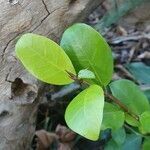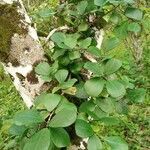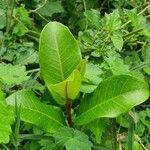Tree up to 30 m. tall or a shrub, hemi-epiphytic or (? secondarily) terrestrial.. Leafy twigs 2–5 mm. thick, glabrous or sparsely and minutely puberulous, periderm not flaking off.. Leaves in spirals to almost distichous and often subopposite; lamina ± coriaceous, oblong to elliptic or ± obovate, 2.5–10 × 1–4.5 cm., apex acuminate to obtuse, rounded or emarginate, base acute to obtuse, margin entire; both surfaces glabrous; lateral veins 6–13 pairs, midrib usually not reaching the apex of the lamina, tertiary venation reticulate to parallel to the lateral veins; petiole 0.5–2(–3) cm. long, 1–2(–2.5) mm. thick, glabrous; stipules 0.2–1 cm. long, glabrous or sometimes minutely and sparsely puberulous, caducous.. Figs in pairs in the leaf-axils or sometimes also just below the leaves, initially enclosed by a small or sometimes up to 1.5 cm. long almost glabrous calyptrate bud-cover; peduncle 0.2–1 cm. long; basal bracts 2–2.5 mm. long, caducous.. Receptacle often shortly stipitate at least when dry, globose to ellipsoid or obovoid, ± 1.5–2 cm. in diameter when fresh, 0.8–1.5(–1.9) cm. when dry, glabrous, reddish, orange or yellowish (to brown) at maturity; wall rather thin, usually wrinkled when dry, apex plane or slightly protruding.
Leaves spirally arranged, or ± distichous, often subopposite; lamina oblong to elliptic or obovate to broadly obtriangular, occasionally lanceolate, 2.5–10 x 1–4.5 cm., subcoriaceous; apex shortly acuminate to obtuse or subacute to rounded or emarginate; base acute to obtuse; margin entire; both surfaces glabrous; lateral veins 6–13 pairs, midrib usually not reaching the apex of the lamina, tertiary venation reticulate or ± parallel to the lateral veins; petiole 5–20(30) mm. long, 1–2(2.5) mm. thick, glabrous; stipules 2–10 mm. long, glabrous or puberulous, caducous.
A fig. It is an evergreen tree. It can be a shrub or a strangler. It lives off other plants. It grows up to 8-30 m tall. It can spread 15 m wide. The leaves vary a lot in shape. They are often thick, leathery and triangle shaped. They are 3-9 cm long by 1-4 cm wide. They occur in rings like a four leaf clover. The leaf tip is blunt. The fig fruit are 1.5 cm across. They are rusty brown.
Receptacle often shortly stipitate, at least when dry, globose to ellipsoid or obovoid, c. 1.5–2 cm. in diam. when fresh, 0.8–1.5 cm. in diam. when dry, glabrous, reddish-orange or yellowish (to brown) at maturity; wall (rather thin) usually wrinkled when dry, apex plane or slightly protruding.
Figs in pairs in the leaf axils or sometimes also just below the leaves, initially enclosed by a calyptrate bud cover, up to 1.5 cm. long, subovoid and ± glabrous; peduncle 2–10 mm. long; basal bracts 1.5–2.5 mm. long, caducous sometimes subpersistent.
Tree up to 30 m. tall, or a shrub, hemi-epiphytic or secondarily terrestrial, sometimes semi-scandent.
Leafy twigs 2–5 mm. thick, glabrous or sparsely minutely puberulous, periderm not flaking off.
A shrub or tree up to 40 ft. high, sometimes epiphytic at first
Figs becoming reddish.




